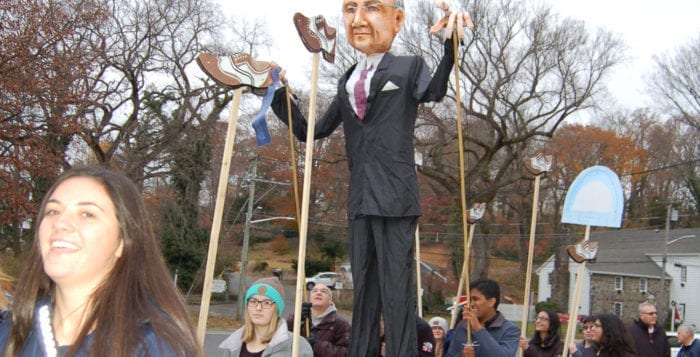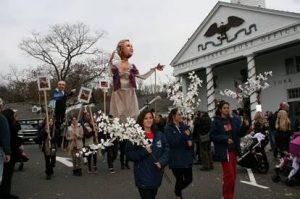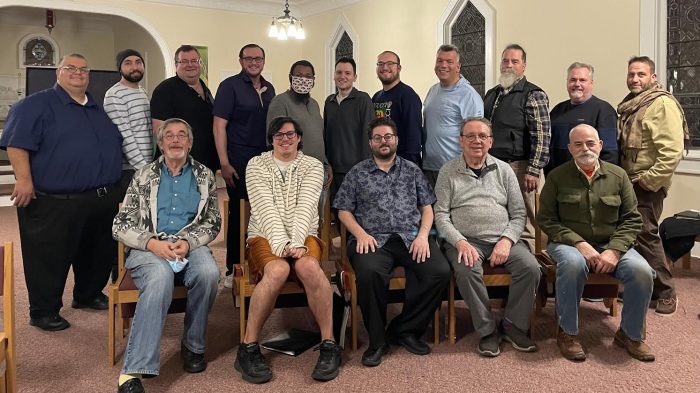Just in time for the holidays, Theatre Three in Port Jefferson hosts its 2nd annual Toy and Gift Drive for Open Cupboard at Infant Jesus R.C. Church on Sunday, Dec. 5. Please note new drop off location! They will be collecting unwrapped toys and gifts at the old Infant Jesus Convent Building at 110 Hawkins Street, Port Jefferson from 9 a.m. to noon. Examples of needed items include puzzles, board games, dolls (baby, Barbie, Frozen), soccer balls, basketballs, arts and crafts, Legos, Paw Patrol, LOL Surprise, jewelry making kits and Beyblades. Call 631-938-6464 for further details.
Recipe with video: Fresh Ginger Cookies
Showstopping Cookies with a Crunch
(Culinary.net) Sweet treats are a favorite food, especially when they have a unique or unusual twist that makes them stand out from the crowd. When a dessert isn’t the classic chocolate or vanilla flavor, it can pique eaters’ interest. Cupcakes, macaroons and even pies have some intense flavors, however, it’s hard to top the delightful taste of these Fresh Ginger Cookies.
They are sweet and sugary with the perfect amount of ginger. Baked until golden brown, this dessert is a showstopper for family events and celebrations alike. Even the little ones will love to munch on this sweet treat with fresh, appealing flavor.
From parties to picnics, these cookies can be a hit. They are simple to make, don’t take much time to bake and are unique enough to bring along to nearly any occasion. With ground and fresh ginger, these cookies are equally as appetizing as they are satisfying and sure to turn heads in the kitchen.
Fresh Ginger Cookies
Yield: Serves 24
Ingredients:
2 cups flour
1 1/2 teaspoons baking soda
1 1/2 teaspoons ground ginger
1 teaspoon ground cinnamon
1/8 teaspoon salt
3/4 cup salted butter, softened
1 cup, plus 3 tablespoons, sugar, divided
1/4 cup brown sugar
1 egg
1/4 cup grated fresh ginger
Directions:
Heat oven to 350 F. In medium bowl, whisk flour, baking soda, ground ginger, cinnamon and salt. Set aside. In stand mixer, beat butter, 1 cup sugar and brown sugar until fluffy. Add egg and fresh ginger; beat until combined. Gradually add dry ingredients to mixer until combined. In small bowl, add remaining sugar. Using spoon, portion out dough, roll into balls then roll in sugar. Arrange balls on baking sheet at least 1 inch apart. Bake 14 minutes, or until edges are golden brown. Transfer cookies to cooling rack and cool completely
See video here.
Find more sweet treat recipes at Culinary.net.
If you made this recipe at home, use #MyCulinaryConnection on your favorite social network to share your work.
Festive light shows brighten Suffolk County this holiday season
By Tara Mae
Suffolk County’s festive light shows have returned to illuminate the holiday season. Whether you prefer a starlit stroll or a cozy car trip, the unique displays at the Vanderbilt Museum, Smith Point County Park, Suffolk County Farm and Education Center, and Splish Splash Water Park offer peaceful reprieves from the hustle and bustle of everyday life.
Bright Lights

Now in its second year, Bright Lights, a magical holiday celebration, returns to the Suffolk County Vanderbilt Museum and Planetarium, 180 Little Neck Road in Centerport.
A collaboration with Redmax Events, the display is open form 5 to 9 p.m. Fridays to Sundays through Dec. 19, and Wednesday and Thursday, Dec. 22 and 23. The event features holiday lights, wandering carolers, festive music, tasty treats, and themed light-up displays.
Santa Claus and his friends, including reindeer, snow people, gingerbread people, nutcrackers, and elves, will all be there, portrayed by costumed actors. The Posey School of Dance will perform The Nutcracker on Dec. 17, 18 and 19.
“We’re thrilled to invite everyone to kick off the holiday season and celebrate with us. The decorated Estate grounds will become a winter wonderland,” said Executive Director Elizabeth Wayland-Morgan. “As you walk through the estate at night, it’s as if you’re entering a magical children’s book.”
Admission for members of the museum is $20 per adult, $10 per child age 12 and younger, children under the age of 3 are free. For nonmembers of the museum, admission is $25 per adult, $15 per child age 12 and younger, children under the age of 3 are free. Tickets may only be purchased online. For more information, visit https://www.vanderbiltmuseum.org/events/bright-lights.
Smith Point Light Show

Girl Scouts of Suffolk County’s annual holiday drive-thru display, the Smith Point Light Show, will be held daily (except Dec. 24, 25, 31 and Jan. 1) through January 9, from 5 to 9 p.m. Located at Smith Point County Park Campground 1, William Floyd Parkway in Shirley, it features 1.5 miles of lights on the beachfront land that is part of Fire Island.
“It’s the 18th annual show at Smith Point. The Girl Scouts partner with Suffolk County Executive Steve Bellone to put it together. Many of the lights and displays were designed by girl scouts who won a special contest and then assembled by Girl Scout staff. The show benefits the Girl Scouts of Suffolk County, including funding for programs, campgrounds’ maintenance, stewardship system, and community outreach,” Multimedia Designer for Girl Scouts of Suffolk County Elena Rios said.
Tickets are sold online or in person. Via the website, tickets are $22 per car and $25 per car at the gate. No cash transactions will be accepted. For more information, visit www.smithpointlightshow.com or call 631-543-6622.
Winter Wonderland
Winter Wonderland at the Suffolk County Farm and Education Center in Yaphank first appeared in 2020, and offers a self-guided walking tour through the grounds of the interactive, educational, working farm, which is a Cornell Cooperative Extension.

Visitors may enjoy the light show, farm animals, and photo opportunities as well as hay rides, hot chocolate, and a lantern craft to take home. The event will take place on Dec. 4, 11, and 18, from 4 p.m. to 7 p.m.
“Experiencing the farm at night is super unique and special as we [normally] close at 3 p.m. daily. The farm is magical at night,” said Director of the Suffolk County Farm and Education Center Vicki Fleming.
To attend the show, pre-registration is required. Tickets are $15 per person for people age 3 and older; children under the age of 3 have free admission. For more information or to purchase tickets, visit https://suffolkcountyfarm.campbrainregistration.com. The event ends at 7 p.m.; the last admitted entry is at 6 p.m. For more information, call 631-727-7850.
Located at 350 Yaphank Avenue, Yaphank the farm provide hands-on, research-based learning to participants in its immersive programs, with a focus on agriculture, animal sciences, STEM history, healthy living, and life skills.
Riverhead Holiday Light Show

Now in its fourth year, for the first time the Riverhead Holiday Light Show will be held at Splish Splash Water Park, 2549 Splish Splash Drive in Calverton. The display runs at 5 p.m. on select dates through Dec. 30.
“We’ve got dozens of dazzling, larger-than-life holiday themed displays to delight the entire family! The show is entirely new this year, so returning guests and new visitors alike will be amazed. Visitors are welcomed to bundle up in their car and tune their radio to enjoy the synced light performance as they travel the more than 1 mile route through the Holiday Light Show™,” Marketing Director of Bold Media Madeline Oliveira said. Bold Media produces the event and puts on other holiday light shows throughout the country.
The Riverhead Holiday Light Show syncs to the holiday music playing on participants radios and the displays dance along to the music. And as the largest water park in New York, with over 95 acres to its name, Splish Splash offers plenty of space for a melodious, merry drive.
Tickets are available at http://holidaylightshow.com/riverheadticketcard. General admission is $23 per vehicle and allows admittance for a certain date and time slot. VIP admission is $35 per vehicle and allows admittance for anytime the show is open. For more info, call 631-210-6711.
Theater Review: The audience joins in the fun at Engeman Theater’s ‘Frosty’

By Heidi Sutton
As the weather outside becomes frightful, the Engeman Theater in Northport invites families inside for a heartwarming production of Frosty. The terrific cast, directed by Jennifer Collester with stage manager Jillian Sharpe, brings the holiday musical to life with catchy sing-alongs and plenty of audience participation.
The narrator (Lizzie Dolce) introduces us to Jenny (Meaghan McInnes), a young girl who lives in Chillsville, “a little town way up north that is always covered with a fresh blanket of snow.” The daughter of the Mayor (Matt Rafanelli), Jenny’s favorite thing to do is to play outside. With help from her father, she builds a snowman and names him Frosty. When Jenny puts a scarf around him, Frosty (Justin Autz) magically comes to life and the two become fast friends.
On the other side of town, Ebenezer Pierpot (Jae Hughes), the president of Pierpot Enterprises (a manufacturer of snow shovels, snowblowers, and ice scrapers), wants to build a bigger factory in the park but can’t do that with all the snow. During a meeting at town hall, Pierpot tricks the Mayor into signing a contract to build a machine that will melt all the snow in the town, putting Frosty’s life in jeopardy.
With Chillsville getting warmer by the minute, will Jenny come up with a plan to save Frosty or will he turn into a large puddle of water with a carrot?
I always look forward to reviewing this show because I love to see the children’s faces light up when they realize that they have been invited to become part of the production. They move to the edge of their seats with eager anticipation as they wait for the next question from the narrator or the cast and the next sing-a-long to join in.
During the performance the audience is asked what Jenny should do today (Build a snowman!), to come up with a plan to save Frosty (Move to another town!), help Jenny write a letter to her dad, and wish for snow (and it works!) They also join the narrator in the fun opening number, “Snow!” and the entire cast in a lively rendition of “Frosty the Snowman.”
With the ultimate message that love “is pretty powerful stuff,” this is the perfect show to introduce a child to live theater and is a wonderful way to celebrate the holiday season.
The John W. Engeman Theater, 250 Main St., Northport presents Frosty through Jan. 2. Running time is 90 minutes with a 15-minute intermission. Children’s theater continues with Disney’s Frozen Jr. from Jan. 29 to Feb. 27 and Madagascar – A Musical Adventure from March 26 to May 1. All seats are $20. For more information or to order, call 631-261-2900 or visit www.engemantheater.com.
Simple ways to prolong the life of poinsettias
Poinsettias and their rich red, white or variegated color schemes are the ideal backdrop for Christmas celebrations. In fact, poinsettias are among the most popular decorative flowers during the holiday season. According to the 2013 USDA Floriculture Statistics report, poinsettias accounted for about one-quarter (23 percent) of all flowering potted plant sales that year. Roughly 34 million poinsettia plants are sold in a given season.
Indigenous to Central America, the plant was introduced to North America in the 1820s when Joel Roberts Poinsett, the first United States Minister to Mexico, brought the red-and-green plant back with him from a trip abroad. While millions of poinsettias will be purchased for the holiday season, many mistakenly think their utility ends once New Year’s Day has come and gone. But with proper care poinsettia plants can continue to thrive and bring warmth and beauty to a home long after the holiday decorations have been tucked away.
• Choose a hearty plant. Experts with the University of Vermont Extension Department of Plant and Soil Science say that many people mistake the plant’s leaves for its flowers. The red, white or pink bracts are actually modified leaves. The flowers of the plant are the yellow clustered buds in the center called “cyathia.” Choose poinsettia plants that have buds which are, ideally, not yet open.
• Keep the temperature consistent. Poinsettias prefer a room temperature between 60 and 68 F during the day and 10 degrees cooler at night. Humidity levels between 20 and 50 percent are ideal. Group plants on water-filled trays full of pebbles to help increase humidity levels.
• Place near sunlight. The United Kingdom-based Perrywood floral company advises placing poinsettia plants near a bright windowsill but not in direct sunlight. Do not let a poinsettia touch cold window panes. • Avoid drafts. The plants are sensitive to drafts and changes in temperature. So it’s best to keep poinsettias away from drafty doors, windows, radiators, or fireplaces.
• Don’t drown the roots. Wait until the surface of the compost dries out before watering the plant anew. Also, the decorative foil wrapper that covers pots can trap water and lead to root rot. Remove it or poke holes in the bottom to allow for drainage.
• Cut back plants. Come mid-March, cut back the plant by half to encourage new shoots, suggests the University of Illinois Extension. The plants also can be placed outside in the spring after the risk of frost has passed. Bring poinsettias back in around mid-September to early October to force them to bloom again.
SB Athletico & Middle Country Soccer Club honored for delivering Thanksgiving meals to local Veterans

On Nov. 20, Town officials hand delivered two proclamations to SB Athletico and Middle Country Soccer Club for their efforts in fundraising and donating approximately 350 Thanksgiving meals to Veterans at the Northport VA. The soccer leagues raised funds to purchase and deliver 350 cornish hens and holiday staples, which they delivered to the Northport VA on Nov. 23. Each dinner included a family photo and a letter, written by the soccer players to a veteran thanking them for their service to the county.

“I was humbled to learn that our local youth devoted their downtime to proactively fundraise and deliver Thanksgiving feasts to the brave men and women who swore to protect our great Nation. I want to commend the coaches, league leadership and parents as well. Teaching our youth to honor, respect and care for our Veterans is more than philanthropic. It is character building, and speaks volumes about the integrity and commitment which these young people exhibit in leading by example,” said Supervisor Ed Wehrheim.
Supervisor Wehrheim along with Town Councilwoman Lisa Inzerillo, Town Councilman Tom Lohmann and Town Clerk Vincent Puleo, surprised soccer players, parents and coaches during a Saturday morning practice, presenting the two leagues with the proclamations. The Thanksgiving fundraiser was orchestrated and managed by the league sponsor; Robert Draper of Draper Asset Management, Coach James Malone, Coach Dave Phaff and Executive Board-Registrar Tracy Bordanaro. Peter Kinzie of Mercep Brothers in St James volunteered to both contribute and assist the leagues with purchasing the goods at cost, to help maximize the number of meals delivered.
During the peak of the COVID-19 Pandemic, the soccer players at SB Athletico were deeply involved in giving back to hospitals, nursing homes and healthcare facilities in the area. In between online soccer training, the families of SB Athletico actively fundraised and collected monetary donations. They then purchased supplies from struggling small businesses, cooked and delivered family style meals to hospitals, and nursing homes. The leagues have recently created a new program; TOPSoccer within Middle Country Children’s Soccer club. This program is devoted solely to children with physical, mental or behavioral disabilities, providing them with an environment that is fun and pressure-free to enjoy the game of soccer
Photos from Town of Smithtown
‘Tune In’ to the holiday season with LIGMC’s ‘Home for the Holiday Special’ concerts
There’s nothing like a holiday TV special for unforgettable songs and memories – and the Long Island Gay Men’s Chorus (LIGMC) is celebrating the season by dusting off the songbook for concerts brimming with yuletide classics.
 Featuring legendary musical favorites from “A Charlie Brown Christmas,” “Mr. Magoo’s Christmas Carol,” “How the Grinch Stole Christmas!” and more, LIGMC’s “Home for the Holiday Special” concerts are scheduled for 8 p.m. on Friday, Dec. 10 at Saint Francis Episcopal Church, 1692 Bellmore Ave., North Bellmore, and 7 p.m. on Sunday, Dec. 12 at St. John’s Episcopal Church, 12 Prospect St., Huntington. Tickets are $25 and are available for purchase at the door or online at www.ligmc.org.
Featuring legendary musical favorites from “A Charlie Brown Christmas,” “Mr. Magoo’s Christmas Carol,” “How the Grinch Stole Christmas!” and more, LIGMC’s “Home for the Holiday Special” concerts are scheduled for 8 p.m. on Friday, Dec. 10 at Saint Francis Episcopal Church, 1692 Bellmore Ave., North Bellmore, and 7 p.m. on Sunday, Dec. 12 at St. John’s Episcopal Church, 12 Prospect St., Huntington. Tickets are $25 and are available for purchase at the door or online at www.ligmc.org.
“There’s no getting around the fact that the last few years have been very challenging for so many people. However, such during turbulent times, traditions have been a source of great comfort,” Bradley Meek, President of the LIGMC Board of Directors, said. “That is why the iconic holiday specials we’ve enjoyed throughout the years resonated so deeply with our members and provided the spark of inspiration for choosing the songs we look forward to performing.”
The 16-member LIGMC returned to the concert stage on Oct. 23 with the standing-room-only “Be Our Guest! A Magical Disney Cabaret” at Sayville VFW Post 433, marking the group’s first live performance since February 2020. LIGMC will continue to observe Centers for Disease Control (CDC) guidelines for indoor gatherings during performances.
“Since resuming our rehearsals in September, it has been an absolute joy to work with such a dedicated and enthusiastic group of returning members and new singers,” LIGMC Artistic Director Jeanette Cooper said. “We hope you’ll be able to join us and ‘tune in’ for what promises to be a very special series of performances!”
Contact the Chorus at [email protected] for additional details.
Video: Longwood Estate hosts special holiday program on Dec. 4
 Historic Longwood Estate, Longwood Road and Smith Road, Ridge, presents a special holiday program, Old-Fashioned Sleigh Rides & Hot Cocoa, for children ages 12 and under on Dec. 4 from 11 a.m. to 2 p.m. Explore the grounds of the estate with an old fashioned sleigh ride, view two large train displays and enjoy roasted chestnuts and popcorn on an open fire. Children can visit with Santa (don’t forget your letter!) and have family members take photos. The Town of Brookhaven Youth Bureau will be collecting new, unwrapped toys for children in need through their INTERFACE program. $5 per child. To register, call 631-924-1820.
Historic Longwood Estate, Longwood Road and Smith Road, Ridge, presents a special holiday program, Old-Fashioned Sleigh Rides & Hot Cocoa, for children ages 12 and under on Dec. 4 from 11 a.m. to 2 p.m. Explore the grounds of the estate with an old fashioned sleigh ride, view two large train displays and enjoy roasted chestnuts and popcorn on an open fire. Children can visit with Santa (don’t forget your letter!) and have family members take photos. The Town of Brookhaven Youth Bureau will be collecting new, unwrapped toys for children in need through their INTERFACE program. $5 per child. To register, call 631-924-1820.
Click here for a here sneak peak of the train display: IMG_8101
WMHO’s Holiday Festival to return to Stony Brook Dec. 5

The Ward Melville Heritage Organization (WMHO)’s 42nd Annual Holiday Festival will return on Sunday, December 5th from noon to 6 p.m. at the Stony Brook Village Center, 111 Main St., Stony Brook with Santa, performances, displays, activities and more. This is an entirely free event.

The festival will feature music from WALK 97.5 throughout the day, Wiggs Optician’s Holiday Train Display, carolers, a performance from Roseland Dance Studio and a petting zoo. The Bethel AME Choir will be returning to help brighten spirits with a performance.
Children can write letters to Santa and mail them at the Stony Brook Post Office in the red “Mail for Santa” mailbox as soon as November 22. Letters can be mailed to Santa through the season.
WMHO’s Youth Corps Santa Fund fundraiser will include a scavenger hunt with the chance to win Stony Brook Village Center gift certificates, Discovery Cruise tickets and other prizes. All proceeds will be donated to Long Island Adolescent to benefit children in need over the holidays.

While the festivities are in full swing, festival goers can participate in the Holiday Tree Festival by voting for their favorite trees as they will be decorated that day. Ballots can be found in all establishments in Stony Brook Village. Voting will take place from December 5 to December 20.
At 5:30pm, Santa will arrive on a holiday float, and with some children from the community, will light the holiday tree on the Village Green.
The sponsors of the 42nd Annual Holiday Festival and the 42nd Annual Holiday Tree Competition are Roosevelt Investments, Damianos Realty Group, GSE Dynamics, LIDL, Central Semiconductor Corp., The Suffolk Center for Speech and Myofunctional Therapy and Armor Corporation.
For more information about the Holiday Festival, the WMHO Youth Corps Santa Fund or the WMHO, call (631) 751-2244.
###
Founded in 1939, WMHO is a not-for-profit corporation that develops and fosters community enrichment through cultural and educational experiences. WMHO accomplishes this by enhancing and interpreting its historic and environmentally sensitive properties and by utilizing state-of-the-art technology. For more information, please visit www.wmho.org
Holiday Gift & Toy Drive-Thru returns to St. James Dec. 4
The St. James Fire Department Engine Company No. 1 will hold its 2nd annual St. James Community Holiday Gift & Toy Drive-Thru on Saturday, December 4 at Gyrodyne/Flowerfield in St. James from noon to 4 p.m. Visitors will enter via the entrance on Route 25A. Donations of an unwrapped toy or gift card are requested.
This year, multiple St. James organizations are collaborating on the event. The organizations are as follows:
St. James Fire Department Engine Co. 1
Celebrate St. James
Troop 7 Boy Scouts
Smithtown High School East Leadership
Smithtown High School East Chamber Choir
Veterans Recovery Coalition
St. James Girl Scouts Troop
St. James Civic Association
Smithtown Food Pantry
Gyrodyne/Flowerfield
Live holiday music will be performed by John Zollo, lead singer of The Dedications, as well as performances by the Smithtown High School East Chamber Choir.
Santa will make an appearance on a Fire Engine with a mailbox handy for children to drop off their letters. All donations will be distributed by the Smithtown Township Emergency Food Pantry to families and children in the community.
Toy donations can also be dropped off at TD Bank, 621 Lake Avenue, St. James, during business hours. Gift cards can be mailed to: St. James Holiday Gift & Toy Drive, c/o Celebrate St. James, 459 Lake Avenue, St. James, NY 11780. In the event of bad weather, the event will be held on Sunday, December 5th.
For more information, call (631) 584-5799.











